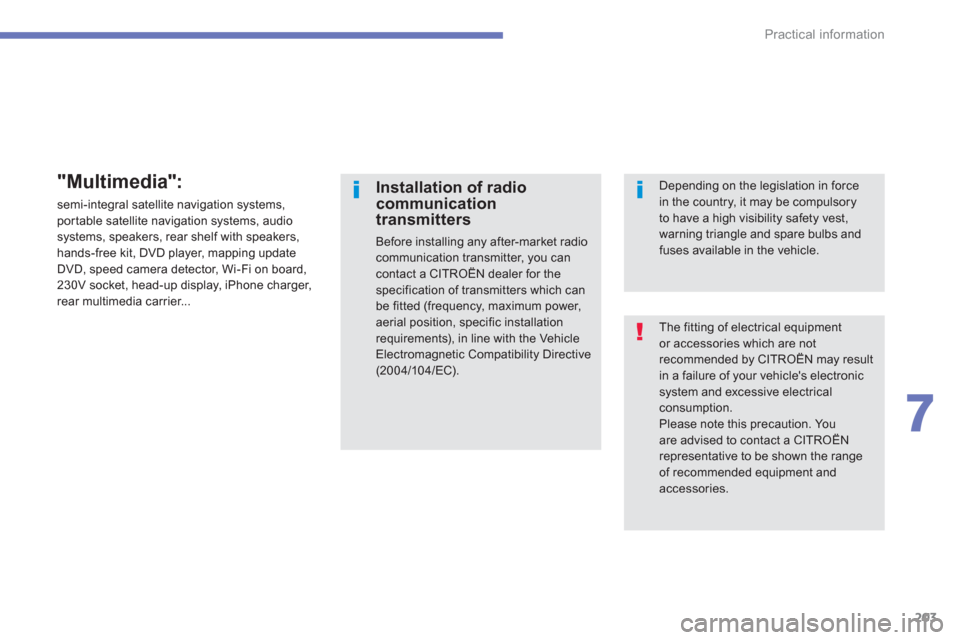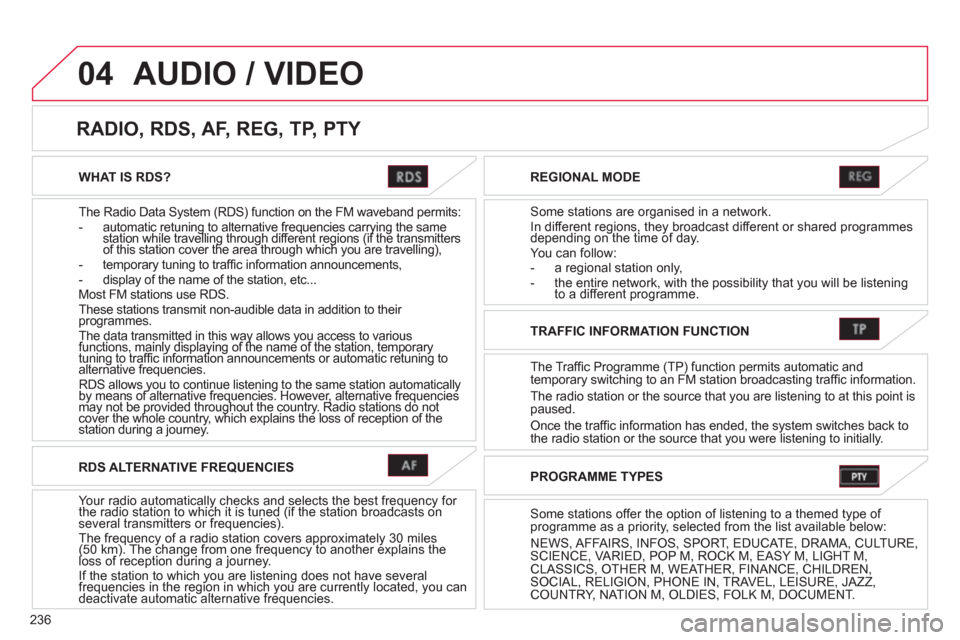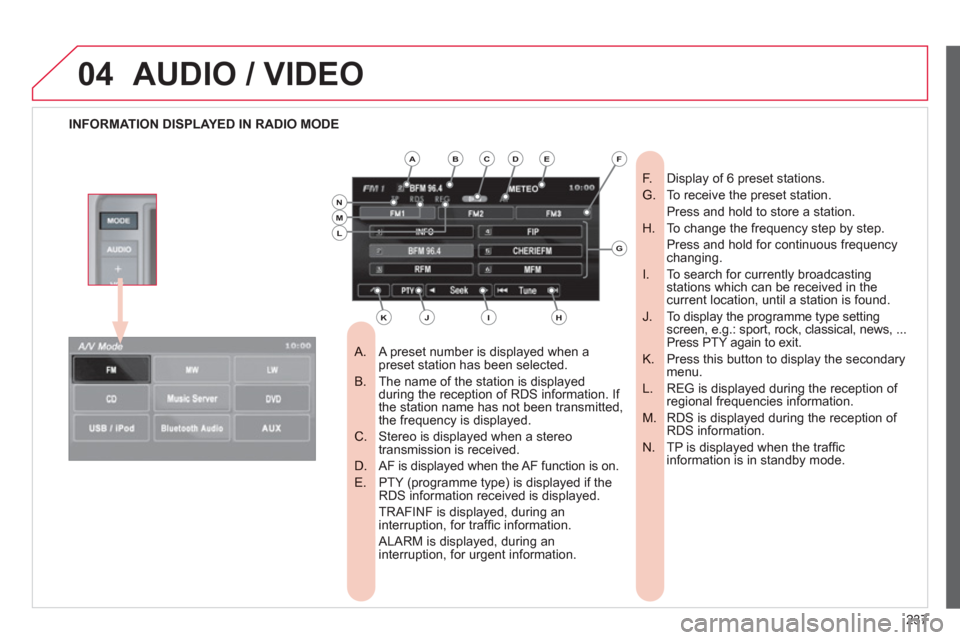2011.5 Citroen C4 radio
[x] Cancel search: radioPage 10 of 332

8
Familiarisation
Interior
4-wheel drive system with
electronic control *
This system allows the selection of a
transmission mode, according to the drivingconditions.
CVT gearbox
This system offers driving combining a fully automatic mode and a manual mode.
Digital air conditioning
This automatic air conditioning system maintains
the desired comfor t level and adequate air circulation in the passenger compartment.
Audio and communication
systems
These systems benefit from the following
technologies: radio, CD player, USB player, Bluetooth system, satellite navigation system
with colour screen, auxiliary sockets.
AUDIO-TELEMATIC system
122
113
92 28
3
223
AUDIO- CD system
*
Depending on version.
Page 108 of 332

106
Driving
Starting - stopping the engine with the key
- Position 1: LOCKThe steering is locked.
- Position 2: ACCThe accessories (radio, 12 V socket...) can be used.
- Position 3: ONIgnition on.
- Position 4: STARTStarting the engine.
Ignition switch
If you use the accessories for aprolonged period (with the key in position 2 (ACC)), you risk dischargingthe battery. Star ting your vehicle will then no longer be possible. Be aware. See the "Automatic power cut-off toaccessories" section.
Key in ignition
A buzzer sounds on opening the driver'sdoor, if the key has been left in the ignition.
�)
Inser t the key in the ignition switch.�)
Turn the key to position 2 (ACC)
and unlock
the steering column, by turning wheelslightly.�) Press and hold the brake pedal.�)
Fully depress the clutch pedal (vehicles fitted with a manual gearbox). �)
Put the gear lever into neutral (vehicles fitted with a manual gearbox), or in position P(vehicles fitted with a CVT
gearbox). �) Operate the star ter by turning the key to
position 4 (START).�) Once the engine is running, release thekey.
The key returns automatically to
position 3 (ON).
Starting using the key
Stopping
�)Immobilise the vehicle. �)Put the gear lever into neutral (vehiclesfitted with a manual gearbox), or inposition P
(vehicles fitted with a CVT gearbox).�)While pressing the key, turn it toposition 1 (LOCK).�)Remove the key from the ignition switch.�)Lock the steering.
Do not attach any heavy objects to the key as this could weigh down on it whenin the ignition switch and cause a fault.
For Diesel vehicles, when the engineis cold wait with the ignition switchin position 3 (ON)
until the preheater warning lamp goes off, before turning
the key to position 4 (START)
. The warning lamp does not come on when the engine is hot.
Page 109 of 332

107
4
Driving
Starting - stopping the engine with the Keyless Entry and
Starting system
With the electronic key inside the vehicle; each press on the " START/STOP " button, with no
action on the pedals, changes the vehicle's mode:�)First press (ACC mode), the button's
warning lamp comes on in orange.
The accessories (radio, 12V socket...) can be used.�)Second press (ON mode), the button's
warning lamp comes on in green.
Switching on the ignition.�)Third press (OFF mode), the warning lamp
in the button goes off.
If you use the accessories for aprolonged period with the ignition switch in position 2 (ACC), you risk dischargingthe battery. Star ting your vehicle will then no longer be possible. Take care.See the "Automatic power cut-off to accessories" section.
Changing the mode of
the vehicle
If the warning lamp flashes orange,contact a CITROËN dealer or a
qualified workshop as soon as possible.
�)Press and release the " START/STOP" button.
�)
With the electronic key inside the vehicle,
depress the clutch pedal fully on vehicles
with a manual gearbox or press the brake pedal on vehicles with a CVT gearbox.
Starting using the
electronic key
For vehicles fitted with a manual gearbox , put
the gear lever in neutral.
For vehicles fitted with a CVT gearbox , put thegear lever in P.P
Page 205 of 332

203
7
Practical information
The fitting of electrical equipment or accessories which are not recommended by CITROËN may resultin a failure of your vehicle's electronicsystem and excessive electrical consumption.
Please note this precaution. Youare advised to contact a CITROËNrepresentative to be shown the range of recommended equipment and accessories.
Installation of radiocommunicationtransmitters
Before installing any after-market radiocommunication transmitter, you cancontact a CITROËN dealer for thespecification of transmitters which can be fitted (frequency, maximum power,aerial position, specific installation requirements), in line with the Vehicle Electromagnetic Compatibility Directive (2004/104/EC).
Depending on the legislation in forcein the country, it may be compulsory to have a high visibility safety vest,warning triangle and spare bulbs andfuses available in the vehicle.
"Multimedia":
semi-integral satellite navigation systems, portable satellite navigation systems, audiosystems, speakers, rear shelf with speakers, hands-free kit, DVD player, mapping update
DVD, speed camera detector, Wi-Fi on board,
230V socket, head-up display, iPhone charger,
rear multimedia carrier...
Page 226 of 332

224
01FIRST STEPS
AUDIO: select Audio-video (FM, CD, musicserver, ...) or Navigation (map) display.
V
OL: adjust audio-video volume.
SCALE: change the scale of the map.
P
OWER: audio system on/off (only).
OPEN: opens the screen andgives access to CD/DVD.
A second press closes the
screen.
ENT:
confi rms the choice of the itemselected in the screen.
For certain operations, con
fi rmation is given by pressing the touch screen.
Scroll the map displa
yed or selection of an
item.
Move a fi n
ger over the screen to operate
the system.
Use the buttons o
ffered on the screen.
For safet
y reasons, the driver
must only carry out operations
which require prolonged
attention with the vehicle
stationary.
Mute on/off.
Next or
previous selection for:
- a radio station,
- an audio track
(CD),
- a chapter
(DVD).
Set the audio volume.
Chan
ge the audio-video source (FM, CD, music server, ...).
Page 227 of 332

225
02GENERAL OPERATION
MODE: Audio-videomenu for:
- radio,
- audio, MP3 or WMA
CD,
- music server,
-
DVD.
MENU: Navigation-guidancemenu for
selecting:
- a
destination,
- a point of interest (POI),
- an advanced search by P
OI,
- one o
f the 20 previous destinations,
- an address stored in the address book,
- the return home,
- certain navi
gation settings,
-
a route demonstration.
NAVI: displa
y of the current location on
the map.SET: Settings
menu for:
- switchin
g off the screen,
- se
lecting the sound setting,
- se
lecting the picture quality,
- selecting the language, the time zone
or the units,
- selectin
g the size of the DVD picture,
- selectin
g the guidance voice, the screen colour schemes or display of
the audio-video icon,
- setting certain equipment available in your vehicle.
INF
O: Informationmenu for theconsultation or adjustment of certain settings for your vehicle.
DESCRIPTION OF THE CONTROLS - MENUS
Page 238 of 332

236
04
WHAT IS RDS?
The Radio Data
System (RDS) function on the FM waveband permits: - automatic retuning to alternative frequencies carrying the samestation while travelling through different regions (if the transmittersgqyggqyg
of this station cover the area through which you are travelling),gg g(gg g(
- temporary tuning to traffi c information announcements,
- display of the name of the station, etc...
Most FM stations use RDS.
These stations transmit non-audible data in addition to their programmes. The data transmitted in this way allows you access to variousfunctions, mainly displaying of the name of the station, temporary yyyy
tuning to traffi c information announcements or automatic retuning to y pyg p yy pyg p
alternative frequencies.gg
RDS allows you to continue listening to the same station automatically by means of alternative frequencies. However, alternative frequencies yg yyg
may not be provided throughout the country. Radio stations do not yq qqq
cover the whole country, which explains the loss of reception of the yp g ypg y
station during a journey. y
REGIONAL MODE
Some stations are organised in a network.
In different regions, they broadcast different or shared programmesdepending on the time of day. gyg,y
You can follow:
- a regional station only,
- the entire network, with the possibility that you will be listeningto a different programme.
RADIO, RDS, AF, REG, TP, PTY
AUDIO / VIDEO
RDS ALTERNATIVE FREQUENCIES
Your radio automatically checks and selects the best frequency for the radio station to which it is tuned (if the station broadcasts on yqyyq
several transmitters or frequencies). The frequency of a radio station covers approximately 30 miles(50 km). The change from one frequency to another explains theq y pp yq y pp y
loss of reception during a journey. () g q() g
If the station to which you are listening does not have several frequencies in the region in which you are currently located, you canygyg
deactivate automatic alternative frequencies. qgyqgy
TRAFFIC INFORMATION FUNCTION
The Tra
ffic Programme (TP) function permits automatic and
temporary switching to an FM station broadcasting traffi c information.
The radio station or the source that
you are listening to at this point ispaused.
Once the traffi c information has ended, the system switches back to
the radio station or the source that you were listening to initially.
PROGRAMME TYPES
Some stations offer the option of listening to a themed type of
programme as a priority, selected from the list available below:
NEWS, AFFAIRS, INF
OS, SPORT, EDUCATE, DRAMA, CULTURE,SCIENCE, VARIED, POP M, ROCK M, EASY M, LIGHT M, CLASSICS, OTHER M, WEATHER, FINANCE, CHILDREN,SOCIAL, RELIGION, PHONE IN, TRAVEL, LEISURE, JAZZ,COUNTRY, NATION M, OLDIES, FOLK M, DOCUMENT.
Page 239 of 332

237
04AUDIO / VIDEO
INFORMATION DISPLAYED IN RADIO MODE
A preset number is displayed when a
A. preset station has been selected.
The name of the station is displayed
B. during the reception of RDS information. If
the station name has not been transmitted,
the frequency is displayed.
Stereo is displayed when a stereo
C. transmission is received.
AF is displayed when the AF function is on.
D.
PTY (programme type) is displayed if the
E. RDS information received is displayed.
TRAFINF is displayed, during an interruption, for traffi c information.
ALARM is displayed, during an interruption, for urgent information.
Display of 6 preset stations.
F.
To receive the preset station.
G.
Press and hold to store a station.
To change the frequency step by step.
H.
Press and hold for continuous frequency changing.
To search for currently broadcasting
I. stations which can be received in the current location, until a station is found.
To display the programme type setting
J. screen, e.g.: sport, rock, classical, news, ...
Press PTY again to exit.
Press this button to display the secondary
K. menu.
REG is displayed during the reception of
L. regional frequencies information.
RDS is displayed during the reception of
M. RDS information.
TP is displayed when the traffi c
N. information is in standby mode.
ABCDE
G
HIJK
LMN
F